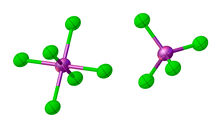Molecular autoionization
Molecular autoionization (or self-ionization) is a reaction between molecules of the same substance to produce ions. If a pure liquid partially dissociates into ions, it is said to be self-ionizing.[1]:163 The oxidation number on all atoms in such a reaction remains unchanged. Such autoionization can be protic (H+
transfer), or non-protic.
Examples
Protic solvents
Protic solvents often undergo some autoionization:
- 2 H
2O ⇌ H
3O+
+ OH−
The self-ionization of water is particularly well studied, due to its implications for acid-base chemistry of aqueous solutions.

Structure of solid phosphorus pentachloride, illustrating its autoionization into PCl4+ and PCl6-.[2]
Non-protic solvents
Coordination chemistry
Autoionization is not restricted to neat liquids or solids. Solutions of metal complexes exhibit this property. For example, compounds of the type FeX2(terpyridine) are unstable with respect to autoionization [Fe(terpyridine)2]2+[FeX4]2−.[3]
See also
References
- 1 2 3 4 5 6 Housecroft C.E.; Sharpe A.G. (2005). Inorganic Chemistry (2nd ed.). Pearson. ISBN 0130-39913-2.
- ↑ Finch, A.; Fitch, A.N.; Gates, P.N. (1993). "Crystal and Molecular structure of a metastable modification of phosphorus pentachloride". Journal of the Chemical Society, Chemical Communications: 957–958. doi:10.1039/C3993000095.
- ↑ Kamata, K.; Suzuki, A.; Nakai, Y.; Nakazawa, H., "Catalytic Hydrosilylation of Alkenes by Iron Complexes Containing Terpyridine Derivatives as Ancillary Ligands", Organometallics 2012, 31, 3825-3828. doi:10.1021/om300279t
This article is issued from
Wikipedia.
The text is licensed under Creative Commons - Attribution - Sharealike.
Additional terms may apply for the media files.